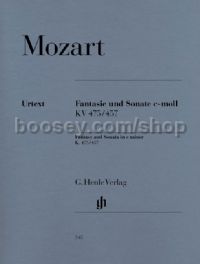Fantasia & Sonata in C Minor, K. 475 & 457 (Piano)
Fantasia & Sonata in C Minor, K. 475 & 457 (Piano)
* Estimated price converted from UK retail price
Following K 333 (315c) Mozart wrote no more sonatas until the great C minor Sonata K 457 of October 1784. Meanwhile he was writing and performing piano concertos – five in quick succession in 1783/84 (K 449, 450, 451, 453 and 456) – for his subscription concerts in Vienna, which at first were very successful. It is no wonder, then, that the virtuoso brilliance on which his success in his subscription concerts depended can be detected in his later compositions. However, the C minor Sonata offers more than this: a shattering expression of personal anguish, and a new language altogether which set this Sonata at the beginning of an epoch. This is the work which made the deepest impression on Mozart’s direct contemporaries and successors, especially on the young Beethoven. Discounting Haydn’s quite different C minor Sonata (Hob. XVI/20), this is the first truly monumental work in the sonata repertory, designed for acoustics more spacious than those of drawing rooms. Although written when Mozart was at the peak of his worldly success in Vienna, in 1784, it is tragic to the core. During that year, he gave more than twenty concerts of his own works all of which were apparently fully booked: even in our modern “concert industry” era it is quite exceptional for a virtuoso, or even a famous composer-virtuoso, to make twenty successive appearances in a single city. Yet it was just at this time that tragedy, objective and subjective, took a grip on Mozart’s life, finally leading to his death in poverty. The C minor Sonata is the first of a series of tragic works in minor keys, which culminates in the unfinished Requiem of 1791.
From the assertive opening on, the first movement is a sustained cry of protest, yielding at the end to a consoling Adagio movement, one of Mozart’s finest inspirations. It may be more than accidental that the A flat major theme of the second episode is almost identical with the adagio theme of Beethoven’s Pathétique Sonata. But the tragedy in Mozart’s Sonata will not be stemmed by this Adagio. It returns with shattering force in the final rondo in which lamentation, protest, resignation, breathless terror and despair are constantly interrupted by silences which render the cries vain and hollow. Yet the classical form is not undermined by all this subjective expression. Mozart’s music achieves greatness through the conquest of personal tragedy by inner order and discipline, and on this level he is Beethoven’s peer. In the first movement, the opening unison statement and its answer – like the themes of the K 491 Piano Concerto and the K 475 Fantasy – lead us to a profoundity which language is powerless to fathom.
C MINOR FANTASY K 475
Although wrote Mozart the great “Fantasie” in which he achieves a unique blending of funeral C minor with demonic chromaticism – six months after the Sonata, he endorsed the intrinsic connection between the two works by publishing them together. They appeared under the title “Fantaisie et Sonate pour le Forte-Piano” in December 1785 with a dedication to Madame Therese von Trattner. Madame von Trattner (1758 1796) was a pupil of Mozart and the wife of Mozart’s wealthy and influential landlord. It has been suggested that an unhappy love affair with her might have provoked the serious expression of both works. However, no proof for this assumption is extant.
This Fantasy might well be ranked as Mozart’s most significant single piano composition. Like the Sonata in C minor, it opens in unison, like the Concerto in C minor, it is chromatic. The chromatic steps around the fifth (F sharp, G, A flat) convey a sense of impeding doom, as they do in the main subject of the Concerto’s first movement. The Fantasy seems freely constructed, but is in fact most tightly knot. The overall shape is a succession of slow, fast and again slow sections, with a return of the first theme towards the end. The chromatically descending bass in measures 10 16 supports bold harmonies, with an almost Schubertian modulation from C minor to B minor. The two slow lyrical sections are in D and in B flat major, i.e. the supertonic of C and its mirror. It is worth noting that due to the intense modulations, this Fantasy has no key designation, but is seemingly written in C major.
Paul and Eva Badura-Skoda




